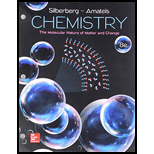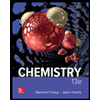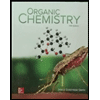
Interpretation:
The solvents are to be ranked in terms of increasing volatility.
Concept introduction:
Volatility is the property that describes how readily vaporizes it. Substances that have high volatility are more likely to exist as vapors than those having low volatility. It is inversely related to the boiling point of the substance. The boiling point of the substance is the temperature at which the vapor pressure of the liquid becomes equal to the atmospheric pressure and the liquid changes into a vapor. Liquids can change into vapors at temperatures below the boiling point through evaporation. It is the process that occurs on the liquid surface due to which it changes into vapors. It is a colligative property because it depends on the number of moles of solute particles that are present in the substance.
Want to see the full answer?
Check out a sample textbook solution
Chapter 13 Solutions
Loose Leaf for Chemistry: The Molecular Nature of Matter and Change
- 3-Methylaniline with NaNO2 in HCl at 0°C and subsequent reaction with water in an acidic medium.arrow_forwardThe reaction of cyclohexanone with diethylamine.arrow_forwardYou're preparing the 2-1 parenteral nutrition that uses potassium phosphate vials (3 mmol of phosphate and 4.4 meq of potassium per mL) to add the phosphate to the parenteral nutrtion. How many meq of potassium are added to the parenteral nutrition when the phosphate is added? Potassium 65 meq Phosphate 24 mmol Sterile water qs ad 2000mlarrow_forward
- The combined calcium and phosphorus in a parenteeral nutrition should not exceed 45 mEq/L. if the parenteral nutrition order shown containes 2mEq PO4/mmol, what is the combined calcium and phosphorus (mEq/L) in the parenteral nutrition order? Parenteral nutrition order: Potassium 65 mEq, Phosphate 24 mmol, Calcium 12 mEqarrow_forwardpls help on all asked.arrow_forward29. The following reaction takes place. A2B(s) = 2A (aq) + B(aq) + heat. If 2.50 moles of A2B is added into a 2.00 L container, it is found that 25.0% of the reactant dissociates to reach equilibrium. Find the solubility product constant, Ksp, for this reaction. Note: Your answer must include an ICE table.arrow_forward
 ChemistryChemistryISBN:9781305957404Author:Steven S. Zumdahl, Susan A. Zumdahl, Donald J. DeCostePublisher:Cengage Learning
ChemistryChemistryISBN:9781305957404Author:Steven S. Zumdahl, Susan A. Zumdahl, Donald J. DeCostePublisher:Cengage Learning ChemistryChemistryISBN:9781259911156Author:Raymond Chang Dr., Jason Overby ProfessorPublisher:McGraw-Hill Education
ChemistryChemistryISBN:9781259911156Author:Raymond Chang Dr., Jason Overby ProfessorPublisher:McGraw-Hill Education Principles of Instrumental AnalysisChemistryISBN:9781305577213Author:Douglas A. Skoog, F. James Holler, Stanley R. CrouchPublisher:Cengage Learning
Principles of Instrumental AnalysisChemistryISBN:9781305577213Author:Douglas A. Skoog, F. James Holler, Stanley R. CrouchPublisher:Cengage Learning Organic ChemistryChemistryISBN:9780078021558Author:Janice Gorzynski Smith Dr.Publisher:McGraw-Hill Education
Organic ChemistryChemistryISBN:9780078021558Author:Janice Gorzynski Smith Dr.Publisher:McGraw-Hill Education Chemistry: Principles and ReactionsChemistryISBN:9781305079373Author:William L. Masterton, Cecile N. HurleyPublisher:Cengage Learning
Chemistry: Principles and ReactionsChemistryISBN:9781305079373Author:William L. Masterton, Cecile N. HurleyPublisher:Cengage Learning Elementary Principles of Chemical Processes, Bind...ChemistryISBN:9781118431221Author:Richard M. Felder, Ronald W. Rousseau, Lisa G. BullardPublisher:WILEY
Elementary Principles of Chemical Processes, Bind...ChemistryISBN:9781118431221Author:Richard M. Felder, Ronald W. Rousseau, Lisa G. BullardPublisher:WILEY





